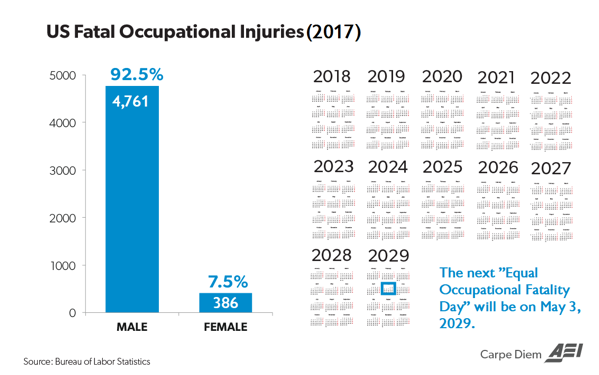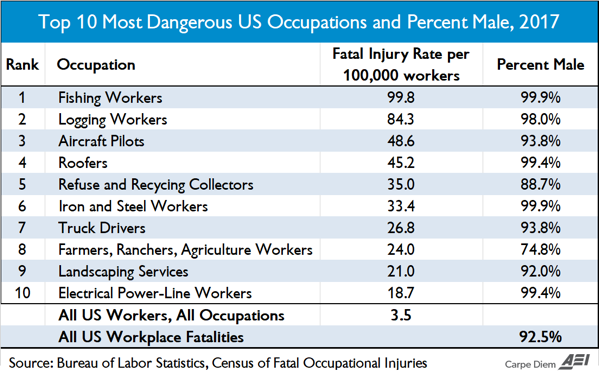

From Mark J. Perry:
Every year the National Committee on Pay Equity (NCPE) publicizes “Equal Pay Day” to bring public attention to the gender earnings gap. According to the NCPE, “Equal Pay Day” fell this year on April 10, and allegedly represents how far into 2018 women will have to continue working to earn the same income that the men earned in 2017, supposedly for doing the same job. Inspired by Equal Pay Day, I introduced “Equal Occupational Fatality Day” in 2010 to bring public attention to the huge gender disparity in work-related deaths every year in the United States. “Equal Occupational Fatality Day” tells us how many years into the future women will be able to continue to work before they will experience the same number of occupational fatalities that occurred for men in the previous year.
The Bureau of Labor Statistics (BLS) released data this week on workplace fatalities for 2017, and a new “Equal Occupational Fatality Day” can now be calculated. As in previous years, the graphic above shows the significant gender disparity in workplace fatalities in 2017: 4,761 men died on the job (92.5% of the total) compared to only 386 women (7.5% of the total). The “gender occupational fatality gap” in 2017 was again considerable — more than 12 men died on the job last year for every woman who died while working.
Based on the BLS data for 2017, the next “Equal Occupational Fatality Day” will occur more than 10 years from now – on May 3, 2029. That date symbolizes how far into the future women will be able to continue working before they experience the same loss of life that men experienced in 2017 from work-related deaths. Because women tend to work in safer occupations than men on average, they have the advantage of being able to work for more than a decade longer than men before they experience the same number of male occupational fatalities in a single year.
Economic theory tells us that the “gender occupational fatality gap” explains part of the “gender earnings gap” because a disproportionate number of men work in higher-risk, but higher-paid occupations like commercial fishing (99.9% male), logging (98% male), pilots (94.0%), and roofers (99.4% male); see 2017 BLS data here. The table above shows that for the ten most dangerous US occupations based on fatality rates per 100,000 workers occupation in 2017 men represented more than 90% of the workers in eight of those ten occupations, and more than 88% of the workers in nine of the ten occupations (see Chart 3 here).
On the other hand, women far outnumber men in relatively low-risk industries, often with lower pay to partially compensate for the safer, more comfortable indoor office environments in occupations like office and administrative support (72.2% female), education, training, and library occupations (73.0% female), and healthcare (75.0% female). The higher concentrations of men in riskier occupations with greater occurrences of workplace injuries and fatalities suggest that more men than women are willing to expose themselves to work-related injury or death in exchange for higher wages. In contrast, women, more than men, prefer lower risk occupations with greater workplace safety, and are frequently willing to accept lower wages for the reduced probability of work-related injury or death. The reality is that men and women demonstrate clear gender differences when they voluntarily select the careers, occupations, and industries that suit them best, and those voluntary choices contribute to differences in pay that have nothing to do with gender discrimination.
‘Equal Pay Day’ this year was April 10 — the next ‘Equal Occupational Fatality Day’ will be on May 3, 2029 | American Enterprise Institute – AEI %
Every year the National Committee on Pay Equity (NCPE) publicizes “Equal Pay Day” to bring public attention to the gender earnings gap. According to the NCPE, “Equal Pay Day” fell this year on April 10, and allegedly represents how far into 2018 women will have to continue working to earn the same income that the …